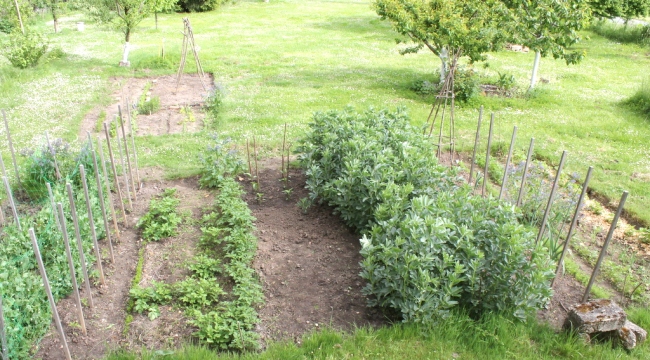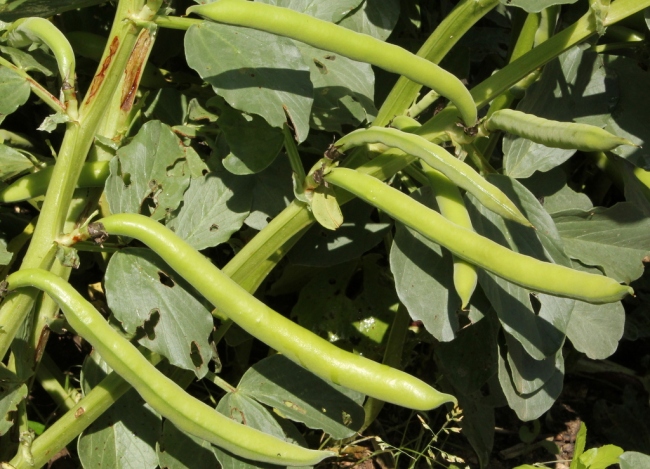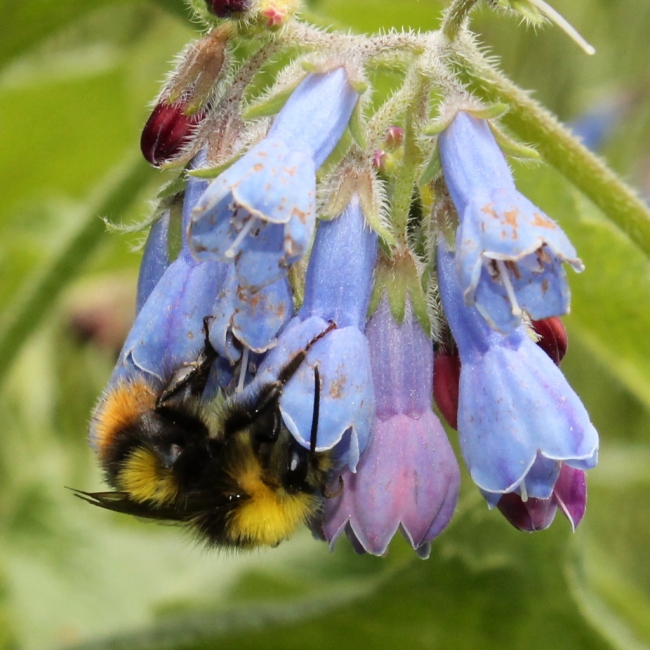Amelia left me in charge of planting the little tomato plants that she had grown from seed. Every time that I thought of planting them my French neighbours warned me that I must wait for les saints de glace to pass. The country folks in most of Europe, especially in this little corner of France still believe firmly in the traditions that must have come through the Middle Ages and maybe beyond.
Special prayers used to be said in all rural churches, to avert a late frost that might damage the crops on Saint Mamert day on the 11th of May, and on Saint Pancrace day on the 12th of May, and also on Saint Servais day on the 13th of May.
I have always respected the local traditions and in addition I don’t want to be taken as a fool by my neighbours. So I waited until this week to finish planting the little seedlings. I will keep my fingered crossed, but may they prosper and may the saints protect them from frost!
So now that the saint ice has passed, I have planted the seedlings. The little tomato plants seem to be doing well next to the peas that are all in flower now.
Our favourite vegetable, the broad beans that we planted last autumn, are now swelling up nicely and should be ready for picking soon. I like cooking a few young beans with their jackets on, and eat them – shell and all – with a little salt and a sprinkling of crushed seeds of the Persian Hogweed, heracleum persicum. This herb grows wild all over Europe. Amelia also cooks a lovely Iranian dish with rice and completely shelled (i.e. minus furry pod and inner bean skin) broad beans and chopped dill. She serves it with roast lamb or roast chicken. It is called baghali polo and that is the king of all rice dishes for me.
Here in France, our neighbours bring raw broad beans on picnics and shell them and eat them with a little butter and salt. I am not exactly keen on that myself, but as they say here: chacun à son goût – each one to their own taste.
One side of the vegetable patch we have a row of mara des bois strawberries, which are now full of flowers and little fruit. Next there is a row of red onions, if you would ignore the weeds (please!), then French flat leaf parsley, and then a row of dill, or as they call it here, aneth. I have not had the heart to pull out the large borage that self seeded from last year, as right through the summer it continuously flowers and attracts the bees. We add the pretty little flowers to salads, and I am told here that the flower and the leaves make a good herbal tea. I must try that!
A few months ago, our friend Michel gave Amelia a clump of comfrey or consoude, as they called it here
The little flowers are very pretty and yes they do attract the bees and the bumble bees. That is why Michel gave them to Amelia. They are now in full flower.
Our little potager, or the vegetable patch is nearly all ready and waiting for Amelia to return. Not that I am complaining, but then my duties as the ghost blogger should also finish.







A lovely wander through your vegetable garden. Our weather was mild enough for me to sow two crops of broad beans. I eat the little green shoots of the Broad bean too. Borage runs wild in my garden.Mostly for the bees but I like eating the flowers too. I had comfrey but it became a menace in its attempts to take over the garden so I have removed as much of it as I can.
LikeLike
I am sure that Amelia, as indeed myself, are glad to hear of your experience regarding Comfrey. We have also been concerned and that is why we planted the clump all near the bottom of the garden, where there is a rough patch near enough to the woodland. If it spreads there, it would hopefully smother other invasive ground covering ivy, etc. – Thanks -K
LikeLike
Comfrey is of course very beneficial and the leaves are wonderful to use for compost and fertiliser and for wrapping around potatoes when I plant them but in a small garden like mine, they were too too prolific.
LikeLike
Our traditional planting date is at the end of May and this year those who thought they could sneak plants in a little early found out why. We had frosts two days this week.
LikeLike
As you say, perhaps there is a lesson for all of us to listen to the advice of our elders. Some old superstitions are really based on wise, practical experience. -K.
LikeLike
So you have Ice Saints too – I wonder why this tradition never jumped the English Channel…
LikeLike
Many mainland Europeans, particularly the farming communities, seem to have retained a lot of their old traditions. At the end of the weather forecasts, every night, they remind people whose saint day will be the next day. In my experience, the British do not completely see themselves as European. – K
LikeLike
your garden is lovely and your photographs are very nice as well.
LikeLike
In Amelia’s absence, I certainly appreciate your comments. You know, I always feel that gardens are not for personal pleasure, but for sharing. We always share the fruits and the vegetables with neighbours. I am so glad that I could also, through this blog, share something with you.- K [Amelia’s husband]
LikeLike
Here, in Two Rock, California the local lore says never to plant before May 10th. In town, a scant 9 miles away, they can plant earlier by weeks. But here, you put your seedlings at risk to put them out before the tenth.
LikeLike
Thanks for that information. It is very interesting. I just wonder whether in that tradition resides some memories from the old settlers who arrived from Europe with the same European culture and traditions. – K
LikeLike
I found the information about the Ice Saints very interesting. I also read about them on Cathy’s blog. The garden is lovely. Here, in Colorado, Mother’s Day is the day most people plant, although a late freeze can occur, even in June.
Linda
http://coloradofarmlife.wordpress.com
LikeLike
Thank you, Linda. You have a totally different climate in Colorado. A few years ago I had the pleasure of spending a week in Aspen. Even in late Spring, I found the weather rather fresh. But I love traditions; whether it is waiting for Ice Saints days or the Mother’s Day. I am sure that mothers knew best! – K [Amelia’s husband]
LikeLike
Les Saints de Glace are also well venerated here in the Midi-Pyrenees – I’m now hoping that the Saints de Pluie will also be soon passed.
My potager is 90% planted – I shall seek out some comfrey to add. This year I have expanded the chard (blette) section, adding a rainbow variety – tried it last year for the first time, and it grew really well, is versatile in cooking and nutritious.
LikeLike
I am not sure if your region is any milder than our region, the Charente-Maritime (17). We don’t certainly get the extreme weathers, but this year’s weather has been certainly very untypical. It is funny you should mention blette (chard), as my friend, Michel brought over a bunch of little plants this week, which I have duly planted. Amelia chops the leaves into a stir fry. They are delicious.
LikeLike
Great to see the bumble and the comfrey.
LikeLike
Amelia has not introduced me properly to “her” bees and bumbles, but there were certainly both the early bumble bees – I find them rather cute – as well as honey bees on the comfrey. K [Amelia’s husband]
LikeLike
The garden was clearly left in safe hands…!
LikeLike
Thank you, That is very kind. Unfortunately it has rained here so much during the last few days that I have not managed to finish all all the gardening work I promised to do. – K
LikeLike
Hello Amelia’s husband. I’ve enjoyed your posts, and I get the sense that you’ve enjoyed writing them. I think you need a monthly guest slot from now on 🙂
I was interested in your comment about Persian Hogweed. I’d never heard of it, so I looked it up. So far as I can tell it pretty much only grows in Iran, Iraq and Turkey, with some odd outposts in Sweden and Norway. Tela Botanica doesn’t list it for France at all, except as ‘to be confirmed’ in Ariege (09). I wonder if you are mistaking Giant Hogweed Heracleum mantegazzianum for it. This species does grow over much of Europe as an invasive alien. I would be very reluctant to use this plant for anything — it is by far the most phototoxic of the genus, and according to Wikipedia that includes the seeds. The survivalists all seem to avoid it. Common Hogweed H. spondylium seeds apparently make a good spice though, and this plant also grows all over Europe. Even so, you have to be careful with any of them and their lookalikes (such as wild parsnip) as it is very easy to get burns from them, and there have been cases of people blinded.
LikeLike
Thank you. You are very kind, but I did enjoy writing, but I would not wish to hijack Amelia’a blog in any way !
As to the plants, you appear to be much more knowledgeable on the subject and much of what you say is absolutely true. For those of us who have lived in Iran and picked the Persian Hogweed, and smelled its beautiful spicy perfume, we will never forget it. Certain variety of European Hogweeds that I have picked in England and in France [the Charente-Martiime (17)], have very similar or slightly less aromatic. I have used them and they were good. However, the other varieties of Hogweed, can be poisonous. But the good news is that none of them – in my experience – have the same large flat seed pods, nor do they have the same smell, when you crush them in your hands. The Persian Hogweed stems are also regularly used in pickles.
I certainly would not recommend anyone to pick wild Hogweeed from the side of the roads in Europe, unless they knew exactly what they were handling.
Thank you for your cautionary comments. K [Amelia’s husband]
LikeLike
Here they say never put plants outdoors (flowers) before 1. week in June. But it might snow after that day, we never know. I bought very small tomatoe plants, now they are growing like superman in my windowsill. my plan is to keep them outdoors, then they should yield tomatoes in September, to be red in october.. I cross my fingers.
LikeLike
In Norway you have a climate colder than us here in South West France. But in any case. this year the weather has been rather strange all over Europe. The problem with buying small tomato plants is always as you have described. Indoors they can grow and become “too leggy”, before the weather permits planting them outdoor. In France many of my neighbours planted the tomatoes even earlier than we did, but wrapped cardboard or plastic around them and watched the weather forecast for any sign of frost.
I wish you all the best with your plants. – K
LikeLike
A delight to read about the fruits of your labour. I will be planting more fruit trees this year.
LikeLike
Many thanks for your kind comments.
I love fruit trees for their flowers; their foliage; the shade that they give us in summer days; and of course their fresh fruits. When I bought our house in France some 12 years ago, the first thing I did, even before making repairs to the house itself, was to plant a number of fruit trees.
I wish you good planting. – K
LikeLike
What a very competent ghost blogger you are! I might have to see if I can persuade my husband to do the same… The vegetable patch looks so full of promise.
LikeLike
Thank you, Rachael.
I appreciate your comments. I only wish that I could have taken as great photographs as yours to accompany the blogs. – K
LikeLike
A lovely post – you are certainly holding the fort during Amelia’s ‘maternity leave’!
The rampant borage gets a stay of execution in our garden too, as the bees love it so.
LikeLike
Thank you. I appreciate your comments.
I have now joined Amelia in Surrey, enjoying a few days with our new grand-daughter who was born on May 15th. – K
LikeLike
I love the helpful little bees in your flower patch – I always get garden-envy from your posts 🙂
LikeLike
Thank you for your comment. Amelia and I love sharing our garden with all the little creatures, whose home it was before we purchased it. The birds and the bees are our favourites. – K
LikeLike